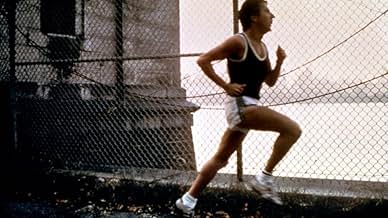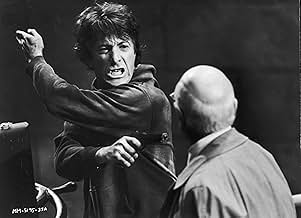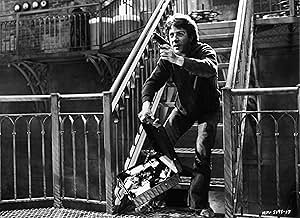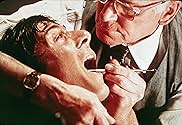Ein Student der Geschichte wird unwissentlich in eine internationale Verschwörung verwickelt, bei der sich alles um gestohlene Diamanten, einen Nazi-Kriegsverbrecher im Exil und einen abtrün... Alles lesenEin Student der Geschichte wird unwissentlich in eine internationale Verschwörung verwickelt, bei der sich alles um gestohlene Diamanten, einen Nazi-Kriegsverbrecher im Exil und einen abtrünnigen Agenten dreht.Ein Student der Geschichte wird unwissentlich in eine internationale Verschwörung verwickelt, bei der sich alles um gestohlene Diamanten, einen Nazi-Kriegsverbrecher im Exil und einen abtrünnigen Agenten dreht.
- Für 1 Oscar nominiert
- 4 Gewinne & 11 Nominierungen insgesamt
- Old Lady on 47th Street
- (as Lotta Andor-Palfi)
- Street Gang
- (as Church)
Empfohlene Bewertungen
Marathon Man is like that; there's something very effective behind its ability to inject terror into a relatively routine situation. That very primal sense of 'running for one's life', whatever the situation, is tapped into perfectly by director John Schlesinger, who paints a bleak and uncomplimentary picture of New York City and of the scummy, lying and double-dealing lowlifes whom inhabit it. Amongst all of this is the character of Thomas Levy (Hoffman), nicknamed 'Babe', a student of history who is attempting to follow in his now deceased father's footsteps by engaging academically in the same field. Babe will later end up following in the same footsteps as his another family member; his brother Henry (Scheider), but for all the wrong reasons. Even Henry is referred to by his nickname for a lot of the film, that being 'Doc', thus repeating the process of use of an alias and tapping into that highly consistent theme of suspicion and what one's true identity is. In a film in which a lot of people act as if they're one thing in order to garner an advantage, this use of improper name and alias to act as an alter-ego is interesting.
But Marathon Man provides us with a ray of light in the form of Babe, a down to Earth and accessible lead with whom we are able to relate in his innocence and copious levels of naivety to his situation when espionage and betrayal catches up with him. In what might appear to be a complex and rather deep story revolving around said narrative characteristics of espionage, smuggling and spies; it is ironic that mere fate brings certain people to New York for certain reasons. This, when a stark disagreement between two elderly men about something that relates to times and events far deeper than mere road rage.
If Babe is a figure cut from a stone that shy but eager in his personality and traits, then Laurence Oliver's Christian Szell, a doctor well informed in the art of dentistry, represents the polar-opposite as this elderly and frail man, but someone who has made a life out of other people's sheer misery; a man that has seemingly existed to inflict pain and suffering wherever he's gone. When we first encounter him, he is a lonesome figure in a heavily fortified and secluded place of dwelling in the middle of a South American jungle. Several newspapers are scattered around, some in English; some in Spanish and some in German which establishes a sense of expertise in language, although the items that stand out are the uncanny skulls which line the shelves, most of which contain odd shaped teeth which catch our eye. The sequence informs us of a man whom requires security and isolation as well as someone whom is most probably trilingual. In one swooping camera shot, we are left to read into as much as we can about this one individual, while a lesser film of the thriller ilk would have seen a bunch of people gather in a room; brought Szell's face up on a screen and laid out everything for the uninformed characters and audience alike.
Babe's involvement in what it is he ends up neck deep in is ultimately instigated by the unsightly sequence in which the death of somebody we do not see coming occurs in his arms. The battered and bloodied body of a blade attack victim acting as the first truly pieces of shocking imagery Babe has seen, the blood from the body staining his plain, bright white vest that he wears thus staining him, and therefore linking him to the world the departing life was connected to. The film is a tight, gripping piece; a film that clashes a world of smuggling, deceit and murder with the quieter, more routine world of a young man who's nervous around girls and just attempting to make-good out of some pretty harsh living conditions.
It progresses to encompass a series of quite extraordinary sequences, the one of which everyone remembers more fondly than others being the torture sequence involving a dentist's drill, a sadomasochistic game of fear; terror; power play; ambiguous questions; honest but disbelieved answers and sheer pain. One other passage of play sees the lead running down a street in the early hours of the morning, whatever light there is being provided by way of the street lamps, as what we perceive to be a wailing, screeching musical score encompassing this, only for it to turn out to be an approaching ambulance which hurtles past, catching us all off guard. Marathon Man is a taut thriller, drawing its audience in and gripping them with a number of basic conventions, raging from the use of a mere MacGuffin to instilling a very visceral, very effective sense of fear by way of ambiguous character intentions and pure threat. If ever there was an essential thriller to see, it may well be Marathon Man.
William Goldman, one of Hollywood's few celebrity screenwriters, wrote both the original novel and the script for this film version. I find him a bit overrated, but here he does a good job of elevating hack-level thriller material into a sort of art form. The beginning of the film is particularly well-written and intriguing, since it's full of creepy and cryptic events that are not immediately explained. But, alas, I find the ultimate explanation of these events to be rather prosaic and disappointing.
So, I think the movie's strengths lie in the acting and directing, more so than the story. Olivier and Scheider give particularly great performances, and Marthe Keller comes across as appropriately sweet and sexy (her big "secret," though, should be really easy for anyone to guess!) I'm a little less enamored of Dustin Hoffman, whose character is inexplicably nicknamed "Babe." He's just way too old to be a typical graduate student (almost forty years old, to be precise), and he simply doesn't have much charisma to me. Usually I like normal-looking, non-glamorous actors, but somehow Hoffman doesn't float my boat.
Still, it's hard not to sympathize with the poor guy while he's being pursued, beaten, tortured etc. The "dental horror" scene is still quite effective, though it's rather short; I was more impressed by the subsequent chase through the dark streets of NYC. (The city, by the way, looks like a hellish, crime-infested, debris-strewn pit in this movie - like it does in most 1970s productions!)
In the end, "Marathon Man" isn't quite another "French Connection," but it's got more than enough suspense to crush a lot of the dross that infests theaters today. It's worth watching just for the terrifying scene when the bad guys start tearing Hoffman's door off its hinges - it's good stuff.
Marathon runner and grad student Thomas "Babe" Levy (Dustin Hoffman) unknowingly crosses paths with Nazi (Lawrence Olivier) attempting to disguise himself as a regular citizen posing as a dentist, for the intention of retrieving some jewels. It was quite an effective chiller during it's time, from director John Schilsinger, especially the well-known drilling of the teeth scene that can be painful to even watch. Dentists were not too popular after the film's release this is part of the reason why. Roy Schneider also stars as Dustin Hoffman's brother Doc Levy as a government agent. Acting veteran received another Best Oscar nomination for this role. The second of 2 movies director John Schlesinger made with actor Dustin Hoffman.
WUSSTEST DU SCHON:
- WissenswertesSir Laurence Olivier took the role of Dr. Szell in part to leave a great deal of money to his wife and children, as he expected to die from the cancer that afflicted him throughout production. He performed the role while undergoing treatment for his cancer, which included heavy doses of painkillers to allow him to work every day. The pain medication affected his memory, and at times Olivier could not remember more than one or two of his lines at a time. In a testament to his fierce concentration, his performance garnered rave reviews and an Oscar nomination, and despite working under such aggressive medical treatment, he experienced a full recovery, allowing him to enjoy the success of this movie, and a series of leading roles that followed.
- PatzerAs Doc approaches LeClerc's shop, he passes a girl in a green sweater. When he leaves the shop a few minutes later, the same girl passes him, still going in the same direction.
- Zitate
Christian Szell: Is it safe?... Is it safe?
Babe: You're talking to me?
Christian Szell: Is it safe?
Babe: Is what safe?
Christian Szell: Is it safe?
Babe: I don't know what you mean. I can't tell you something's safe or not, unless I know specifically what you're talking about.
Christian Szell: Is it safe?
Babe: Tell me what the "it" refers to.
Christian Szell: Is it safe?
Babe: Yes, it's safe, it's very safe, it's so safe you wouldn't believe it.
Christian Szell: Is it safe?
Babe: No. It's not safe, it's... very dangerous, be careful.
- Crazy CreditsThe ending credits scroll with Babe's jogging route as a backdrop.
- VerbindungenEdited from XVIII. Olympische Sommerspiele Tokio 1964 (1965)
- SoundtracksDors, ô cité perverse
(1881)
(from 'Hérodiade')
Music by Jules Massenet
Libretto by Paul Milliet (uncredited) and Henry Grémont (uncredited)
Sung by Joseph Rouleau, with the Orchestra of the Royal Opera House (Royal Opera House Covent Garden Orchestra)
Conducted by John Matheson
Courtesy of London and Decca Records
Top-Auswahl
- How long is Marathon Man?Powered by Alexa
Details
- Erscheinungsdatum
- Herkunftsland
- Sprachen
- Auch bekannt als
- Maratón de la muerte
- Drehorte
- 505 South Flower St, Los Angeles, Kalifornien, USA(Scheider & Olivier converse in front of "Double Ascension" sculpture)
- Produktionsfirma
- Weitere beteiligte Unternehmen bei IMDbPro anzeigen
Box Office
- Budget
- 6.500.000 $ (geschätzt)
- Bruttoertrag in den USA und Kanada
- 21.709.020 $
- Weltweiter Bruttoertrag
- 21.709.020 $
- Laufzeit2 Stunden 5 Minuten
- Farbe
- Sound-Mix
- Seitenverhältnis
- 1.85 : 1
Zu dieser Seite beitragen


































